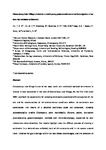Glastonbury Lake Village revisited: a multi-proxy palaeoenvironmental investigation of an Iron Age wetland settlement
| dc.contributor.author | Hill, TCB | |
| dc.contributor.author | Hill, GE | |
| dc.contributor.author | Brunning, R | |
| dc.contributor.author | Banerjea, RY | |
| dc.contributor.author | Fyfe, R | |
| dc.contributor.author | Hogg, AG | |
| dc.contributor.author | Jones, J | |
| dc.contributor.author | Perez, M | |
| dc.contributor.author | Smith, DN | |
| dc.date.accessioned | 2018-12-04T15:50:17Z | |
| dc.date.issued | 2019-01-14 | |
| dc.identifier.issn | 2051-6231 | |
| dc.identifier.issn | 2051-6231 | |
| dc.identifier.uri | http://hdl.handle.net/10026.1/12978 | |
| dc.description.abstract |
Glastonbury Lake Village is one of the most iconic late prehistoric wetland settlements in Europe. A new excavation in the core of Glastonbury Lake Village, for the first time since 1907, provided the opportunity for sampling of deposits associated with occupation of the site and for reconstructing the environmental conditions before the settlement was constructed. The results of a detailed multiproxy study are presented, including palaeoecological proxies (Coleoptera, plant macrofossils, diatoms, pollen, non-pollen palynomorphs), geoarchaeological methods (soil micromorphology), supported by new radiocarbon determinations. The results highlight how the difficult process of creating a settlement in a wetland was achieved, both within structures and in the spaces around them. Evidence for grain storage within the macrofossil assemblages, and the presence of animals on the settlement reflected in coleopteran assemblages and non-pollen palynomorphs has refined our understanding of the interaction between the settlement and the neighbouring dryland. | |
| dc.format.extent | 115-137 | |
| dc.language | en | |
| dc.language.iso | en | |
| dc.publisher | Taylor & Francis | |
| dc.title | Glastonbury Lake Village revisited: a multi-proxy palaeoenvironmental investigation of an Iron Age wetland settlement | |
| dc.type | journal-article | |
| dc.type | Journal Article | |
| plymouth.issue | 2 | |
| plymouth.volume | 18 | |
| plymouth.publication-status | Published | |
| plymouth.journal | Journal of Wetland Archaeology | |
| dc.identifier.doi | 10.1080/14732971.2018.1560064 | |
| plymouth.organisational-group | /Plymouth | |
| plymouth.organisational-group | /Plymouth/Admin Group - REF | |
| plymouth.organisational-group | /Plymouth/Admin Group - REF/REF Admin Group - FoSE | |
| plymouth.organisational-group | /Plymouth/Faculty of Science and Engineering | |
| plymouth.organisational-group | /Plymouth/Faculty of Science and Engineering/School of Geography, Earth and Environmental Sciences | |
| plymouth.organisational-group | /Plymouth/REF 2021 Researchers by UoA | |
| plymouth.organisational-group | /Plymouth/REF 2021 Researchers by UoA/UoA14 Geography and Environmental Studies | |
| plymouth.organisational-group | /Plymouth/Research Groups | |
| plymouth.organisational-group | /Plymouth/Research Groups/Marine Institute | |
| plymouth.organisational-group | /Plymouth/Users by role | |
| plymouth.organisational-group | /Plymouth/Users by role/Academics | |
| dcterms.dateAccepted | 2018-12-04 | |
| dc.rights.embargodate | 2019-2-15 | |
| dc.identifier.eissn | 2051-6231 | |
| dc.rights.embargoperiod | Not known | |
| rioxxterms.versionofrecord | 10.1080/14732971.2018.1560064 | |
| rioxxterms.licenseref.uri | http://www.rioxx.net/licenses/all-rights-reserved | |
| rioxxterms.licenseref.startdate | 2019-01-14 | |
| rioxxterms.type | Journal Article/Review |


